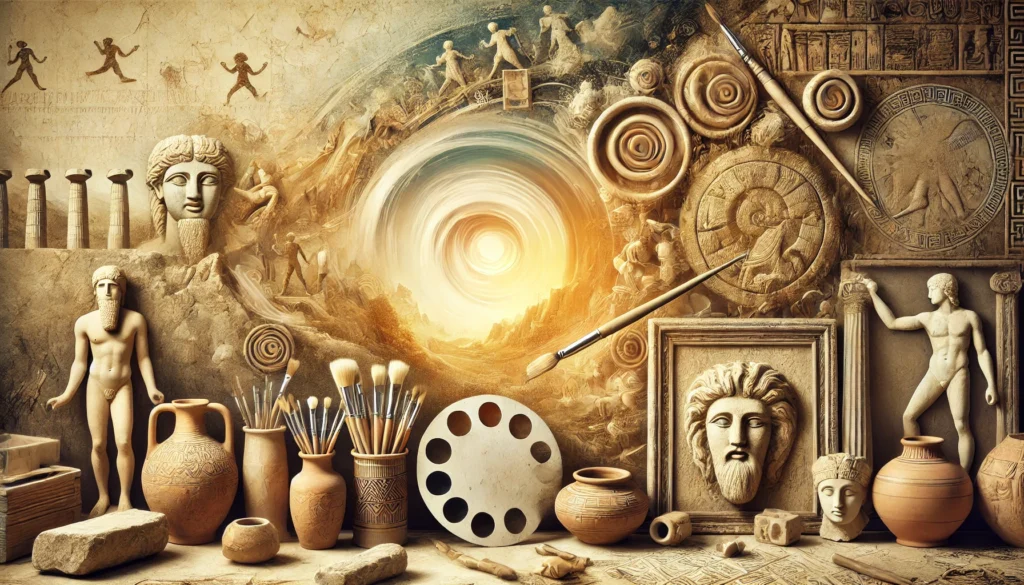Exploring ancient artz takes us on a journey through time, where creativity and cultural expression have left an indelible mark on human history. From Egypt’s monumental architecture to the stunning sculptures of Greece, ancient artz reflects the beliefs, values, and daily lives of civilizations long gone. The art produced by these early societies continues to inspire us today. In this article, we will delve into the origins, cultural significance, and influence of ancient art across different civilizations, while also examining its enduring legacy in modern times.
The Origins of Ancient Artz
The origins of ancient artz can be traced back to the earliest human societies. Art existed even before written language, with cave paintings and rock carvings serving as humanity’s first attempts to express ideas and emotions. Prehistoric art, like the cave paintings of Lascaux, often depicted animals and scenes from daily life, giving us a glimpse into the beliefs and survival struggles of early humans.
As human civilizations evolved, so did their artistic expression. Ancient Egypt, Mesopotamia, and Greece are some of the early cultures that developed distinctive styles of art. These societies used art to tell stories, honor gods, and celebrate their rulers. The development of tools, materials, and techniques in ancient artz led to increasingly sophisticated works that reflected the complexity of their societies.
Artistic Materials and Techniques Across Civilizations
The materials and techniques used in ancient artz were as diverse as the civilizations that created them. Each culture had its preferred mediums, shaped by available resources and their unique cultural practices.
Egyptian Art
The Egyptians are famous for their monumental use of stone, especially in statues, pyramids, and tomb paintings. Their mastery of carving stone allowed them to create massive structures and intricate, detailed reliefs that have survived thousands of years. Funerary art was a significant part of Egyptian culture, designed to honor the dead and ensure safe passage to the afterlife.
Mesopotamian Art
In contrast, Mesopotamians primarily used clay, a more abundant resource in their region. Their art was often in the form of pottery, seals, and statues. Mesopotamian cylinder seals, used to authenticate documents, were intricately carved with detailed scenes depicting religious or royal themes.
Greek Art
The Greeks, renowned for their sculptures, used marble and bronze extensively. Their sculptures, like those of the gods and famous athletes, were known for their realism and attention to detail. The Greeks also pioneered artistic techniques that added movement and expression to their work, a departure from the static forms of earlier periods.
These materials and techniques not only influenced the final appearance of the art but also played a crucial role in defining the style of each civilization’s ancient artz.
The Role of Religion and Society in Ancient Artz
Religion and society were key driving forces behind much of ancient artz. In many ancient cultures, art was not created simply for aesthetic pleasure but served as a means to honor the gods, rulers, or ancestors. Religious themes dominated much of the art in early civilizations.
Egyptian Art
Egyptian art, for example, was deeply tied to their beliefs about the afterlife. Temples and tombs were adorned with elaborate paintings and carvings that depicted the pharaohs’ journey to the afterlife. These works were often symbolic, with each color, pose, and object carrying significant meaning.
Greek Art
In ancient Greece, art was heavily influenced by both religion and philosophy. Temples were decorated with sculptures of gods and mythological figures, with an emphasis on beauty, harmony, and proportion. Greek art also reflected civic pride, with statues of victorious athletes displayed prominently in public spaces, celebrating the human form and physical excellence.
Mesopotamian Art
Mesopotamian art often revolved around kingship and the divine right of rulers. Their famous ziggurats, massive stepped pyramids, were built as religious centers and reflected the importance of religion in their society. Art served to solidify the ruler’s connection to the gods and underscore their authority.
Influence of Women in Ancient Artz
One often overlooked aspect of ancient artz is the role of women, both as creators and subjects. While the majority of ancient art was commissioned by male rulers or religious figures, women played a significant part in the artistic expression of many cultures. In some societies, women were depicted as goddesses or queens, symbols of fertility, beauty, and power.
In ancient Greece, for instance, the goddess Athena was frequently featured in art, symbolizing wisdom and warfare. Similarly, Egyptian art often depicted queens alongside pharaohs, showing their importance in both royal and divine contexts. Additionally, women in ancient Minoan art are portrayed in vibrant scenes of daily life, emphasizing their roles in society.
Highlighting women’s contributions and their depictions in ancient artz adds depth and diversity to our understanding of these early civilizations.
Comparative Analysis: Art Across Civilizations
A comparative analysis of ancient artz reveals that while many civilizations had unique styles, there were also common themes. For instance, the connection between rulers and the divine can be seen in both Egyptian and Mesopotamian art. Similarly, the human form was idealized in both Greek and Roman sculpture, though the Greeks focused more on naturalistic forms, while the Romans emphasized grandeur and power.
This comparison shows that while each civilization had its distinct artistic approach, the underlying motivations were often similar: to honor the gods, legitimize authority, and celebrate cultural achievements.
The Enduring Legacy and Modern Influence of Ancient Artz
The legacy of ancient artz is not confined to museums. It continues to influence modern art and architecture. For example, the symmetrical design principles of ancient Greek temples have inspired neoclassical architecture seen in modern government buildings and monuments. Likewise, Egyptian motifs like the pyramid and sphinx have made their way into contemporary design, especially during the Art Deco period.
Today, artists and designers continue to draw inspiration from ancient artz. The clean lines and geometric shapes of Greek and Roman art influence modern minimalism, while the vivid colors and symbolism of Egyptian art have inspired fashion, film, and even digital art forms. The timelessness of ancient artz is a testament to its lasting influence on human creativity.
Restoration and Preservation of Ancient Artz: Challenges and Debates
One of the most pressing issues surrounding ancient artz today is its preservation. Many ancient artworks have been damaged by time, war, and environmental factors. Efforts to restore these pieces often raise ethical questions. Should modern restorers attempt to recreate missing parts of sculptures or leave them as they are? How much intervention is appropriate?
Additionally, there are debates about the rightful ownership of ancient artifacts. Should treasures like the Elgin Marbles, taken from Greece and displayed in the British Museum, be returned to their countries of origin? These are complex questions that continue to fuel discussions in the art world.
Lesser-Known Ancient Civilizations’ Contributions to Art
While Egyptian, Greek, and Roman art are well-known, there are many other ancient civilizations whose artistic contributions are equally significant but less recognized. For example, the art of the Indus Valley Civilization (modern-day Pakistan and India) includes intricate pottery and bronze sculptures that reflect a highly developed artistic culture. Similarly, the Maya civilization of Mesoamerica is renowned for its elaborate stone carvings and detailed frescoes that depict their religious beliefs and daily life.
Incorporating these lesser-known civilizations into the discussion of ancient artz broadens our understanding of the global scope of ancient creativity.
Conclusion: The Lasting Impact of Ancient Artz
Ancient artz remains a vital part of human history, providing insights into the lives, beliefs, and values of ancient civilizations. From the grand pyramids of Egypt to the elegant sculptures of Greece, these artworks continue to captivate and inspire us today. The materials and techniques, the religious and societal influences, and the legacy of these ancient works show that art was—and continues to be—a powerful form of human expression.
As we continue to explore and preserve ancient artz, we ensure that its influence endures, connecting us with our shared past and inspiring future generations of artists and creators.
FAQ
What is the cultural significance of ancient art?
Ancient art reflects the beliefs, values, and everyday life of early civilizations. It helps us understand their culture and history through visual representation.
How did artistic techniques evolve in ancient societies?
Ancient artists developed new techniques over time, from simple carvings to sophisticated sculptures, utilizing materials like stone, clay, and bronze.
Why is preserving ancient artworks important?
Preserving ancient art is key to maintaining our cultural heritage. It allows future generations to appreciate and learn from the creativity of past civilizations.
How does ancient art influence modern art?
Modern artists and designers often draw inspiration from ancient art, incorporating its styles and techniques into contemporary works.
What role did religion play in ancient art?
Religion was central to much of ancient art, with works often created to honor gods, depict religious rituals, or symbolize beliefs about the afterlife.
How can ancient art provide insights into bygone civilizations?
Ancient art lets us peek into the past. It shows us what people believed in, valued, and did in old times. This helps us understand and appreciate human history more deeply.


